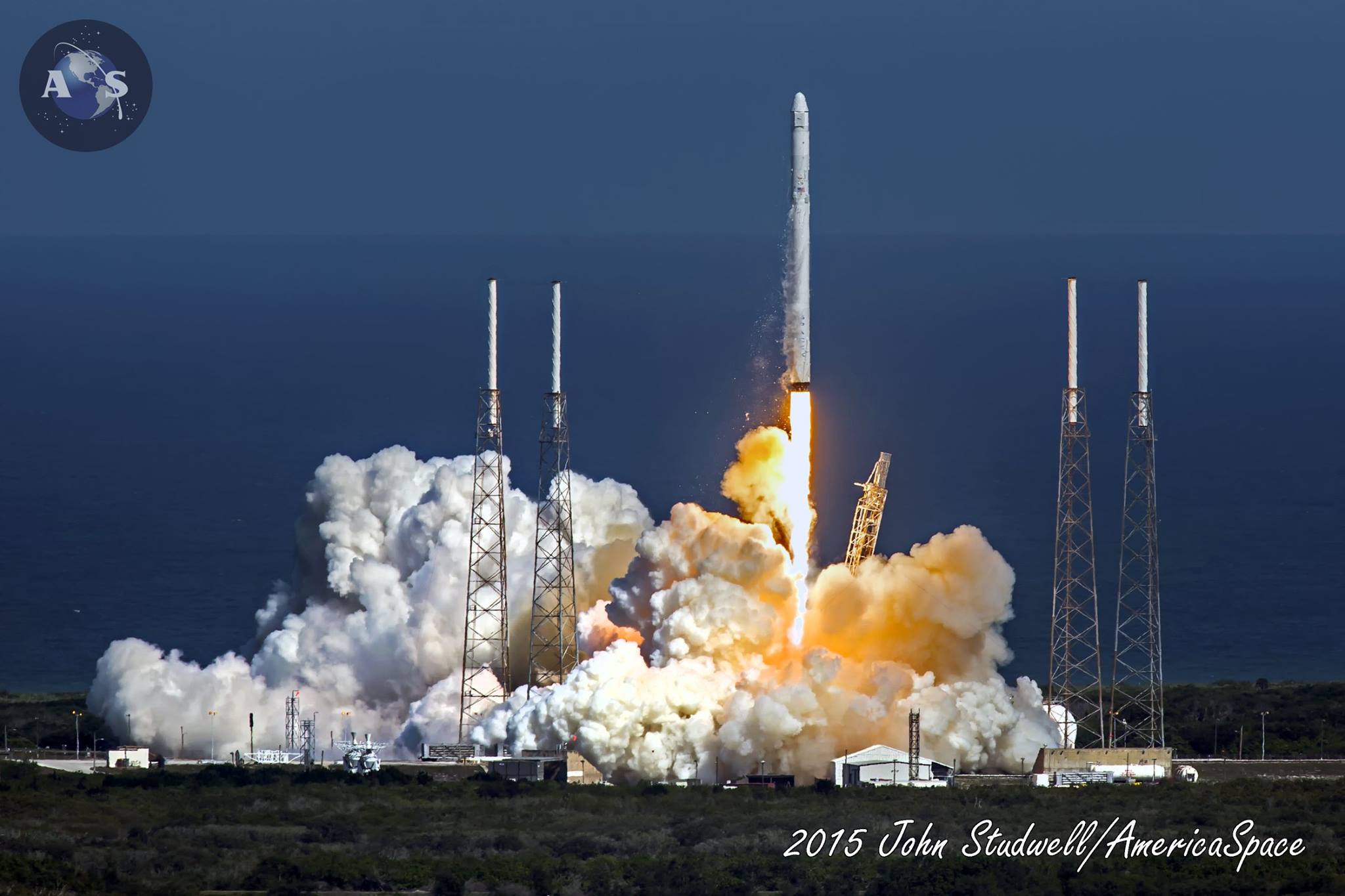
Following a 24-hour delay, caused by unacceptable weather conditions, SpaceX has successfully delivered its latest Dragon cargo mission into low-Earth orbit, carrying about 4,390 pounds (1,990 kg) of provisions, payloads, tools, and scientific equipment to the incumbent Expedition 43 crew of the International Space Station (ISS). Liftoff of the Falcon 9 v1.1 booster, flying for the 12th time in less than 19 months, took place during an “instantaneous” window at 4:10:41 p.m. EDT Tuesday, 14 April, from the storied Space Launch Complex (SLC)-40 at Cape Canaveral Air Force Station, Fla. At the time of writing, the CRS-6 Dragon—SpaceX’s sixth dedicated mission to the ISS, under the terms of its $1.6 billion Commercial Resupply Services (CRS) contract with NASA—had been successfully released into orbit from the second stage of the booster and is presently headed for a rendezvous and berthing at the Earth-facing (or “nadir”) port of the space station’s Harmony node early Thursday, 16 April.
As described in AmericaSpace’s CRS-6 preview article, the Falcon 9 v1.1 was transported to SLC-40 on Saturday, 11 April, for the standard Static Fire Test of the nine Merlin 1D engines on its first stage. “Static is complete,” SpaceX confirmed to AmericaSpace late Saturday afternoon. “Everything is looking good for Monday.” In fact, the primary violation for an on-time launch appeared to be the weather, which was reported by the 45th Weather Squadron at Patrick Air Force Base as 60 percent favorable during its update at 10 a.m. EDT Monday. “Summer-like weather continues across Central Florida,” it was noted. “Warm temperatures and afternoon thunderstorms are expected to continue for the next several days. Most thunderstorm activity will be inland today, as low-level winds are easterly along the Space Coast, helping to push the sea breeze inland quickly. However, with upper-level westerly winds, thunderstorms will tend to drift back toward the Spaceport late this afternoon, soon after T-0.” It was added that primary issues were the possible violation of the Anvil Cloud Rule and the Cumulus Cloud Rule.
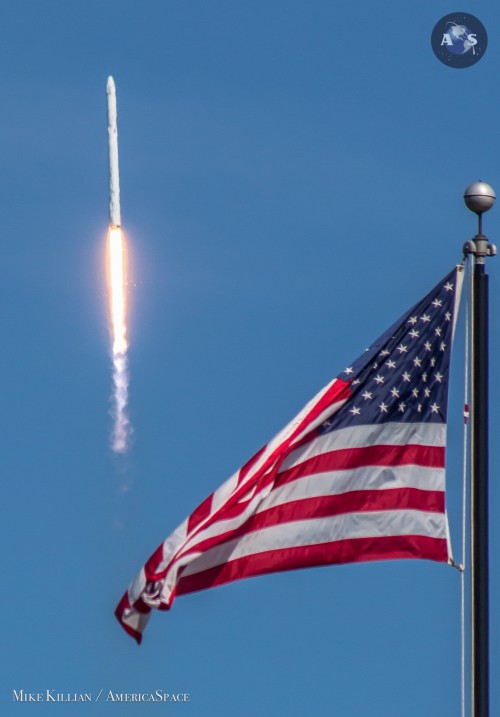
Due to the nature of Dragon’s destination—the ISS—it was imperative that the launch must occur precisely on time. Unlike several other missions, there existed no margin to accommodate last-minute technical issues or poor weather conditions. If the vehicle could not launch on time, the attempt would be scrubbed and the countdown clock recycled to track a second opportunity on Tuesday afternoon. In spite of the 60 percent chance of acceptable conditions, SpaceX teams pressed ahead with Monday’s opening launch attempt and the Falcon 9 v1.1 was fueled with liquid oxygen and a highly refined form of rocket-grade kerosene, known as “RP-1.”
The cryogenic nature of the oxygen—whose liquid state exists within a range from -221.54 degrees Celsius (-368.77 degrees Fahrenheit) to -182.96 degrees Celsius (-297.33 degrees Fahrenheit)—required the fuel lines of the engines to be chilled, in order to avoid thermally shocking and potentially fracturing them. All propellants were fully loaded within one hour, and the vehicle’s tanks transitioned to “Topping Mode” shortly after 3 p.m. Shortly thereafter, the L-1 Hour Weather Briefing declared conditions to be “Green” (“Go”), although this remained tentative, in view of the changeable conditions. “The Falcon 9 weather criteria are all met, including the upper-level winds,” AmericaSpace’s Launch Tracker reported at 3:41 p.m. “There is a concern about a cell of anvil thunder clouds moving west to east, about 25 miles (40 km) from the pad. These seem to be dissipating, as they are heading east, but the Weather Officer is keeping an eye on them. A storm system that affected Titusville has moved away north of the Cape and is not an issue anymore.”
With the commencement of SpaceX’s live webcast, it was pointed out by Falcon 9 Product Director John Insprukter that the lightning and anvil clouds were “almost within constraint limits” and it was clear that the probability of launching on Monday hung on a knife-edge. At 4:20 p.m., the countdown reached its final “Go/No-Go” polling point of all stations at T-13 minutes. By this point, T-0 had been refined to 4:33:16 p.m., and after passing smoothly through each of the polls the Launch Director (LD) was able to issue a “Go” to press ahead with the Terminal Count at T-10 minutes. During this phase, the Merlin 1D engines were chilled, ahead of their ignition sequence. All external power utilities from the Ground Support Equipment (GSE) were disconnected and at 4:28 p.m., the roughly 90-second process of retracting the “strongback” from the vehicle got underway. It was confirmed as being fully retracted and ready for launch by 4:29:46 p.m.
Then, a “Hold! Hold! Hold!” call from a member of the launch team was called at T-3 minutes and 10 seconds. In view of the instantaneous nature of CRS-6’s window, it was immediately obvious that a scrub was unavoidable and the countdown clock halted at T-3 minutes and 7 seconds. As the strongback was elevated back alongside the vehicle, more details of the cause of the scrub emerged: a violation of the Anvil Cloud Rule. “The Launch Commit Criteria (LCC) violation was called due to a storm cell entering the 10-mile (16 km) limit,” noted AmericaSpace’s Launch Tracker, “which is attached directly via a storm system that contains lightning.”
With the clock recycled to track a backup opportunity at 4:10:41 p.m. EDT Tuesday, the forecast seemed gloomy, with just a 50-50 likelihood of acceptable conditions at T-0. “On Tuesday, the low-level flow turns more south-westerly and may impede the westward migration of the sea breeze,” noted the 45th Weather Squadron at Patrick Air Force Base in their Monday morning briefing. “This will keep the thunderstorm triggering mechanism much closer to the Spaceport, increasing the risk for Lightning, Cumulus Cloud and Anvil Cloud Rule violations.” Nevertheless, by the time the 45th issued an updated forecast at 9:00 a.m. EDT Tuesday, it had removed the Lightning risk element and enhanced the probability of acceptable weather conditions to 60 percent.
For the second time in as many days, SpaceX teams moved ahead with a satisfactory poll for fueling at 12:55 p.m. EDT Tuesday and by 2:40 p.m. all propellants had been fully loaded and the Falcon 9 v1.1 transitioned into “Topping Mode.” As the boiled-off liquid oxygen departed the vehicle and billowed away as a stream of white vapor, it was continuously replenished until close to T-0. “Weather is looking good right now,” AmericaSpace’s Launch Tracker pointed out at 3:28 p.m. EDT. “Unlike yesterday, there are no Anvil Storm Clouds anywhere near the 10-mile (16 km) restriction area and other criteria are looking good for launch time.” Yet with an instantaneous window, it was apparent that if the final polling point was not passed at T-13 minutes and if the Terminal Count did not commence at 4:00:41 p.m. EDT, Tuesday’s attempt would also be scrubbed.
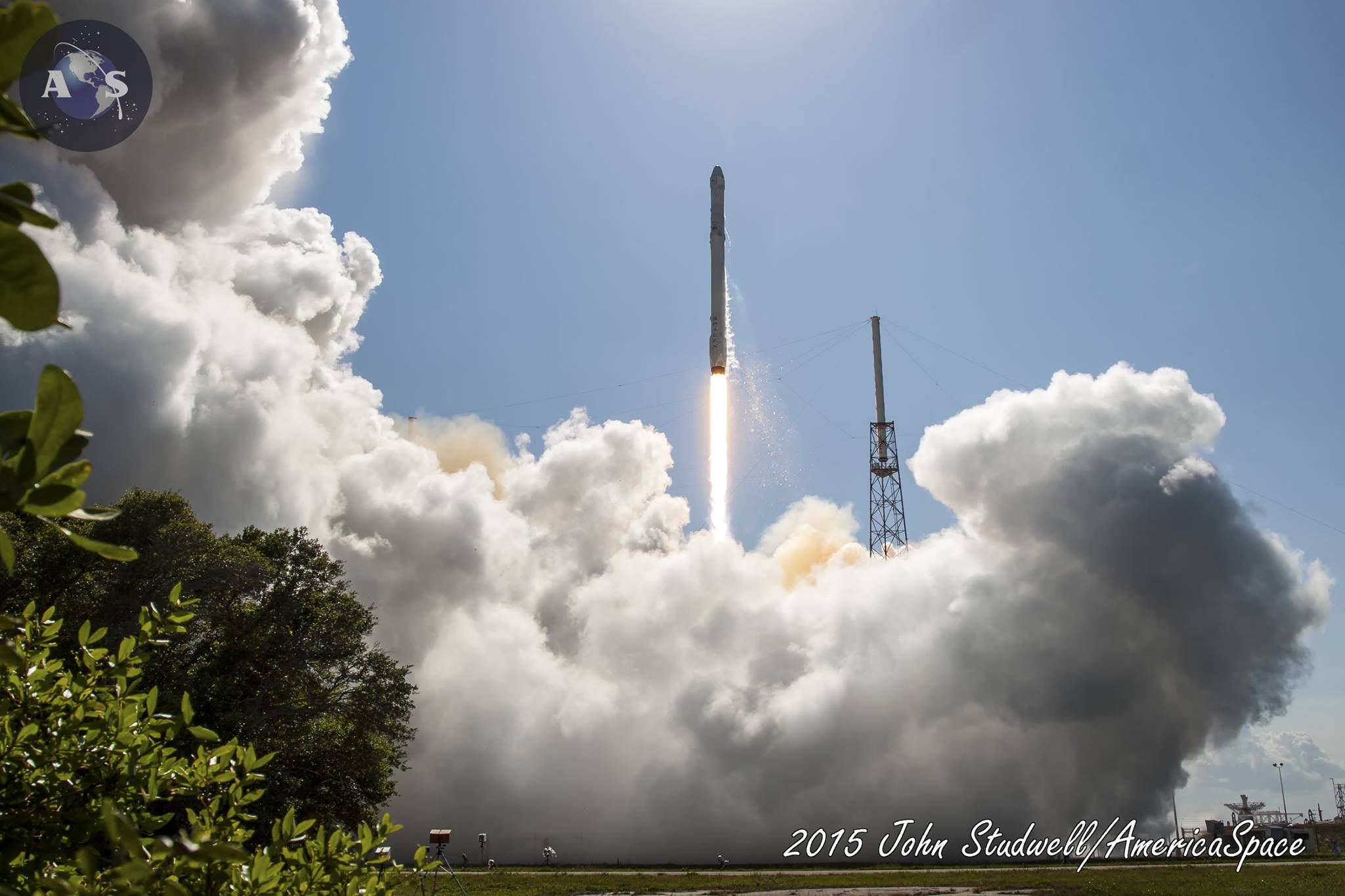
With crystal blue skies and a few scattered wisps of cloud over the Cape, it seemed a good day for SpaceX to fly. The countdown passed perfectly through the final poll at T-13 minutes and into the Terminal Count. Again, the nine Merlin 1D engines were chilled, preparatory for ignition, and all external GSE utilities were disconnected. At 4:05:11 p.m., the process of retracting the strongback commenced and was complete within 90 seconds. Passing beyond the point of yesterday’s scrubbed attempt, the Flight Termination System (FTS)—which is tasked with destroying the rocket in the event of a major accident during ascent—was placed onto internal power and armed. By T-2 minutes and 15 seconds, the first stage’s propellant tanks had attained flight pressure, and at T-2 minutes the Range Operations Co-ordinator (ROC) confirmed Range clearance to support the launch. In this final phase, the Merlin 1D engines were purged with gaseous nitrogen and, at T-60 seconds, the SLC-40 complex’s “Niagara” deluge system of 53 nozzles were activated, flooding the pad surface and flame trench with 30,000 gallons (113,500 liters) of water, per minute, to suppress acoustic energy radiating from the engine exhausts.
At T-3 seconds, the nine Merlins roared to life, ramping up to a combined thrust of 1.3 million pounds (590,000 kg). Following computer-commanded health checks, the stack was released from SLC-40 at 4:10:41 p.m. EDT. Immediately after clearing the tower at T+10 seconds, the booster executed a combined pitch, roll, and yaw program maneuver to establish it onto the proper flight azimuth to inject the CRS-6 Dragon into low-Earth orbit. Eighty seconds into the uphill climb, the vehicle exceeded the speed of sound and experienced a period of maximum aerodynamic duress—colloquially dubbed “Max Q”—on its airframe. At about this time, the Merlin 1D Vacuum engine of the second stage underwent a chill-down protocol, ahead of its own ignition later in the ascent. At 4:13:11 p.m., 130 seconds after liftoff, two of the first-stage engines throttled back, under computer command, in order to reduce the rate of acceleration at the point of Main Engine Cutoff (MECO).
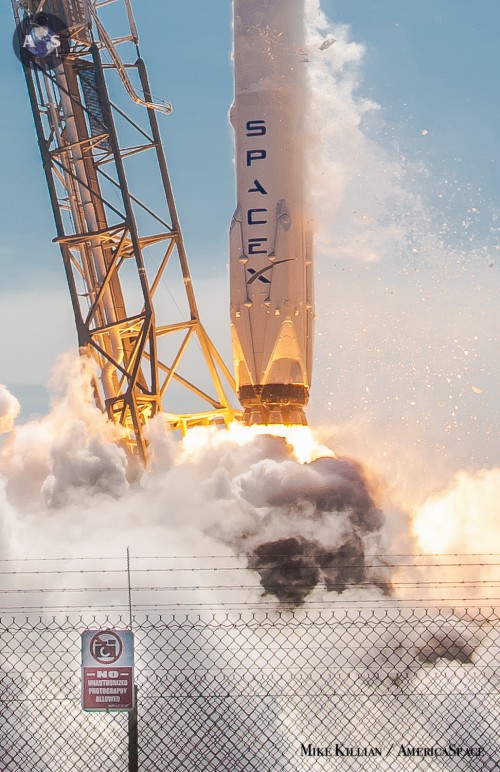
Finally, at T+2 minutes and 58 seconds, the seven remaining engines shut down, and, a few seconds later, at 4:13:31 p.m., the first stage separated from the rapidly ascending stack. The turn then came for the restartable second stage, whose Merlin 1D Vacuum engine—with a maximum thrust of 180,000 pounds (81,600 kg)—ignited at 4:13:38 p.m. to continue the boost into orbit. Based upon previous Dragon missions, it burned for about six minutes and 45 seconds to inject the cargo ship into a “parking orbit.” During this period, the protective nose fairing, which covers Dragon’s berthing mechanism, was jettisoned.
Twelve minutes after departing the Cape, at 4:22:21 p.m., the sixth dedicated ISS-bound Dragon separated from the second stage and unfurled its two electricity-generating solar arrays, deployed its Guidance and Navigation Control (GNC) Bay Door to expose critical rendezvous sensors and began the intricate sequence of maneuvers to reach the ISS on Thursday, 16 April.
In the meantime, another mission had begun. Shortly after the separation of the Falcon 9 v1.1’s first stage, the initial steps to return the vehicle to a soft landing got underway. Its target was the Autonomous Spaceport Drone Ship (ASDS)—a 288-feet-long (87.8-meter) x 100-feet-wide (30.5-meter) Marmac 300 Freight Barge, equipped with diesel-powered azimuth thrusters, repurposed from oil rigs—positioned about 200 miles (320 km) out in the Atlantic Ocean, to the north-east of Cape Canaveral. This is part of SpaceX’s continuous effort to develop a fully reusable capability for its Falcon 9 v1.1 hardware. A previous attempt during the CRS-5 launch in January achieved partial success, for although the first stage reached the deck of the barge, a premature exhaustion of hydraulic fluid to the hypersonic grid fins caused it to impact at a 45-degree angle and exploded. Original plans for another attempt during the Deep Space Climate Observatory (DSCOVR) launch in February were called off due to rough sea conditions.
As described in a recent article by AmericaSpace’s Mike Killian, repairs were conducted and a planned series of upgrades to make the ASDS more stable in rough waters were announced as being underway by SpaceX founder Elon Musk. On Tuesday, 7 April, the two primary support vessels—the Elsbeth III, which draws the ASDS out to sea, and the Go Quest, which carries communications and tracking hardware—put to sea, reaching an approximate distance of about 10 miles (15 km) off Port of Jacksonville to evaluate improvements made in advance of the CRS-6 landing attempt. Following these tests, the Elsbeth III returned to port at 6:36 a.m. EDT on Wednesday, 8 April, ahead of its deployment for dedicated CRS-6 mission operations at 3:37 a.m. EDT Saturday, 11 April.
At the point of separation, the 150-foot-tall (46-meter) first stage was traveling at a velocity of about 2,900 mph (4,670 km/h) and maintaining stabilization has been likened to someone balancing a rubber broomstick on their hand, in the middle of a fierce windstorm. Three Merlin 1D engine firings were executed in order to steadily reduce this velocity and stabilize the first stage. An initial “Boost-Back” burn began at 4:18 p.m. EDT and served to adjust the vehicle’s impact point, pushing it “upward” and directing it back towards the Cape. Shortly afterwards, the FTS was deactivated.
Assisted by nitrogen thrusters, the first stage successfully flipped over and a “Supersonic Retro-Propulsion” burn slowed it to about 560 mph (900 km/h). A final “Landing” burn was intended to bring this velocity down still further to just 4.5 mph (7.2 km/h). The first stage will utilize compressed helium to deploy its four extendable landing legs and a quartet of lattice-like hypersonic grid fins—configured in an “X-wing” layout—were expected to be unfurled to control the lift vector. Coupled with engine gimbaling, these were designed to permit a precision touchdown on the ASDS surface. During January’s partial successful attempt to soft-land Falcon 9 v1.1 first-stage hardware, an exhaustion of hydraulic fluid to the grid fins was initially blamed for the “hard” touchdown. However, at 4:29 p.m. EDT, SpaceX founder Elon Musk tweeted: “Ascent successful. Dragon en-route to Space Station. Rocket landed on drone ship, but too hard for survival.”
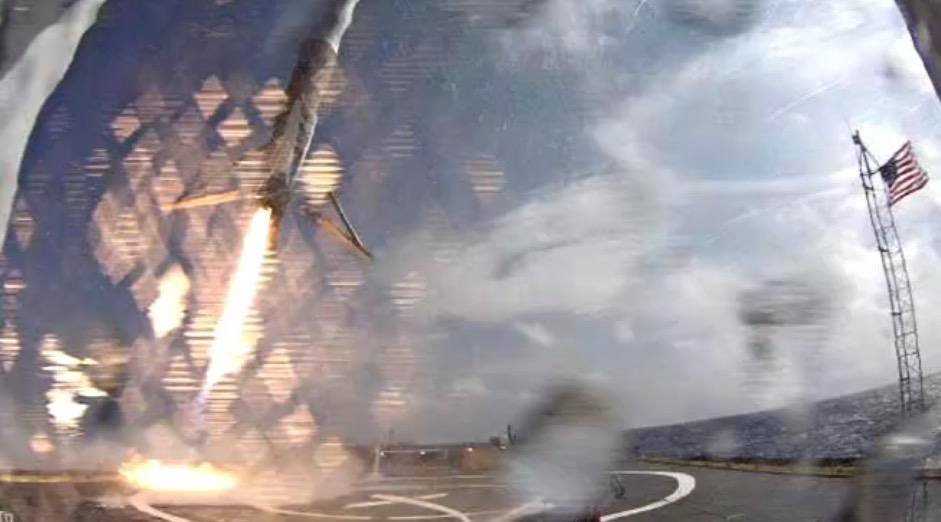
As described in a recent AmericaSpace article, CRS-6 is flying with its unpressurized “Trunk” empty of payloads, but will transport about 4,390 pounds (1,990 kg) of provisions, payloads, tools, and scientific equipment to the station’s incumbent Expedition 43 crew in its pressurized segment. That cargo consists of 1,100 pounds (500 kg) of crew supplies, including care packages from home, food and provisions, 1,140 pounds (518 kg) of miscellaneous items for the station’s Environmental Control and Life Support System (ECLSS) and Electrical Power System (EPS), 1,860 pounds (844 kg) of “Utilization” hardware—including U.S.-sponsored experiments and research payloads from the Canadian Space Agency (CSA), the Japan Aerospace Exploration Agency (JAXA), and the European Space Agency (ESA)—and about 79 pounds (36 kg) of command and data-handling equipment, TV and photographic gear, and EVA tools. According to NASA, the EVA tools include wire ties, one Fan Pump Separator (FPS), and a number of rechargeable battery assemblies for the U.S. Extravehicular Mobility Units (EMUs).
“We watched live!” tweeted Expedition 43 crew member Samantha Cristoforetti, after the successful launch. “Amazing to think that in 3 days #Dragon will be knocking at our door!” CRS-6 marks SpaceX’s fourth launch of the year, following hard on the heels of CRS-5 to low-Earth orbit on 10 January, DSCOVR toward the L2 Lagrange Point on 11 February and, most recently, the Eutelsat 115 West B and ABS-3A communications satellites to Geostationary Transfer Orbit (GTO) on 1 March. This make 2015 the first year in SpaceX’s history that it has delivered missions in as many as four consecutive months. Moreover, the mission fits into a manifest which should see as many as five Dragons flown in 2015, more than twice as many as has ever been achieved in any previous year. If these are executed according to schedule, CRS-6 will be followed by CRS-7 in June and CRS-9 in December, each of which will carry an International Docking Adapter (IDA) to support NASA’s Commercial Crew needs, whilst CRS-8 in September will deliver the Bigelow Expandable Activity Module (BEAM) to the station. To date, SpaceX has launched no more than two Dragons per year since its inaugural Commercial Orbital Transportation Services (COTS) test flight, back in May 2012, and if all goes well the company will complete 50 percent of its initial 12-flight CRS commitment to NASA when CRS-6 reaches the ISS and should reach 75-percent-complete by year’s end.
Want to keep up-to-date with all things space? Be sure to “Like” AmericaSpace on Facebook and follow us on Twitter: @AmericaSpace
Missions » ISS » COTS » CRS-6 »





6 Comments
6 Pings & Trackbacks
Pingback:technology 2day | Bonita Vida
Pingback:VIDEO: Chase Plane Captures SpaceX Rocket Landing Attempt After Successful CRS-6 Dragon Launch « AmericaSpace
Pingback:A Dragon Came A’Calling: Fully-Laden Cargo Ship Arrives at Space Station « AmericaSpace
Pingback:Second SpaceX Mission in Two Weeks Gears Up for Monday Launch « AmericaSpace
Pingback:SpaceX Prepares for Latest in Long History of Critical Pad Abort Tests (Part 1) « AmericaSpace
Pingback:Record-Setting Dragon Returns to Earth, as Record-Setting Year Gathers Pace « AmericaSpace